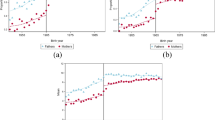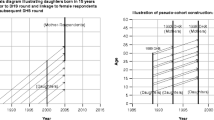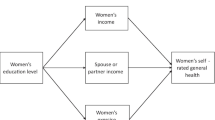Abstract
This study investigates the effects of maternal education on child’s health and health behavior. We draw on a rich German panel data set containing information about three generations. This allows instrumenting maternal education by the number of her siblings while conditioning on grandparental characteristics. The instrumental variables approach has not yet been used in the intergenerational context and works for the sample sizes of common household panels. We find substantial effects on health behavior for adolescent daughters, but neither for adolescent sons nor for the health status of newborns. We show that possible concerns for the validity of the instrument are unlikely to compromise these results. We discuss mother’s health behavior, assortative mating, household income, and child’s schooling track as possible channels of the estimated effects. Maternal education seems to affect daughter’s smoking behavior through the higher likelihood of the daughter pursuing a higher secondary schooling track.


Similar content being viewed by others
Notes
More commonly low birth weight is defined as a birth weight of less than 2,500. However, we encounter the same problem as Lindeboom et al. (2009: 111): with this strict definition we only have a few observations with low birth weight. These observations might be affected by measurement error. Hence, we apply the same definition as Lindeboom et al.
The SOEP collects data on smoking behavior also in the years 1998, 1999 and 2001. These questions, though, differ in their phrasing. Therefore, we exclude information from these survey years.
We also computed the regressions for a slightly different definition of this variable. The results differ only marginally, when we consider a person as being active who is doing sports at least once a month. These and other results not shown are available from the authors upon request.
We also applied different thresholds for the definition of poorer health, used the metric instead of the dichotomized physical health measure and resorted to a different self-rated health item (“How would you describe your current health?”). All these redefinitions of the health status outcome do not change the results presented in Sect. 4.
If the variable years of education is missing for an individual in a given survey year, we use information from other survey years. Following Kemptner et al. (2011), we also employ a different measure of the years of education, in which we only considered years of primary and secondary schooling: 9 years for individuals without school degree and those with basic track degree, 10 years for those with intermediate track school or other degree, 12 years for technical school degree and 13 years for general university-entrance diploma. However, the Probit and IV-Probit results did not change qualitatively, only the size of the coefficient estimates increased.
The SOEP collected this information in 1990, 1996, 2001, 2003 and 2006. We consider siblings inside and outside of the household.
The ISEI score is derived from the occupational status of grandfather and grandmother. SOEP questions on the occupational status of grandfather and grandmother are formulated to reflect the situation when the mother was 16. For each pair of grandparents we make use of the highest ISEI score, which in most cases is the score of the grandfather. Missing values are imputed as described in the “Appendix”.
In the section on robustness checks, we also present results from a two-stage least squares model (2SLS). Being more robust regarding the distributional assumptions of the error terms but less efficient, the estimated effects differ only marginally.
By controlling for both mother’s birth cohort and child’s year of birth, we indirectly control for the mother’s age at birth. Since the mother’s age at child birth is a choice variable and possibly correlated with maternal education, we also run the models without this control variable. The results are insensitive to this modification. These estimates are available upon request from the authors.
The graph displays the numbers for the sample of adolescents with non-missing smoking information. Similar pictures emerge for the other samples.
None of the effect differences between mothers of daughters and mothers of sons is significant at the 5 % level.
We also obtain small and insignificant effects when using birth weight as outcome in 2SLS regressions.
Although the effect on sport activity is rather large and only borderline insignificant.
We do not show sensitivity analyses for newborns because similar to the results in Table 4 the effects are insignificant in all sensitivity analyses.
More specifically, we include dummy variables for 1, 2, 3 and 4 or more children.
We do not find evidence that these effects differ substantially between mothers of daughters and mothers of sons.
Piopiunik (2011) instrumenting maternal education by changes in compulsory schooling legislation finds significant effects of maternal education on sons’ but not on daughters’ education. This paper analyzes the effect of maternal education at the lower tail of the education distribution, while we investigate effects over the whole distribution of maternal education.
References
Andersen, H. H., Mühlbacher, A., Nübling, M., Schupp, J., & Wagner, G. G. (2007). Computation of standard values for physical and mental health scale scores using the SOEP version of SF-12v2. Schmollers Jahrbuch, 127(1), 171–182.
Becker, G. S., Duesenberry, J. S., & Okun, B. (1960). An economic analysis of fertility. In National Bureau of Economic Research (Ed.), Demographic and economic change in developed countries (pp. 225–256). Princeton: Princeton University Press.
Becker, G. S., & Lewis, H. G. (1973). On the interaction between the quantity and quality of children. Journal of Political Economy 81(2), 279–288.
Black, S. E., & Devereux, P. J. (2011). Recent developments in intergenerational mobility. In O. Ashenfelter & D. Card (Eds.), Handbook of labor economics 4B chapter 16 (pp. 1487–1541). Amsterdam: Elsevier.
Black, S. E., Devereux, P. J., & Salvanes, K. G. (2005). The more the merrier? The effect of family size and birth order on children’s education. Quarterly Journal of Economics, 120(2), 669–700.
Card, D. (1999). The causal effect of education on earnings. In O. C. Ashenfelter & D. Card (Eds.), Handbook of labor economics 3A (Vol. 3, pp. 1801–1863). New York: Elsevier.
Carneiro, P., Meghir, C., & Parey, M. (2007). Maternal education, home environments and the development of children and adolescents. IZA Discussion Paper, 3072.
Chevalier, A., & O’Sullivan, V. (2007). Mother’s education and birth weight. IZA Discussion Paper, 2640.
Coneus, K., & Spiess, C. K. (2012). The intergenerational transmission of health in early childhood: Evidence from the German Socio-Economic Panel study. Economics and Human Biology, 10(1), 89–97.
Currie, J. (2009). Healthy, wealthy, and wise: Socioeconomic status, poor health in childhood, and human capital development. Journal of Economic Literature, 47(1), 87–122.
Currie, J., & Moretti, E. (2003). Mother’s education and the intergenerational transmission of human capital: Evidence from college openings. Quarterly Journal of Economics, 118(4), 1495–1532.
Cutler, D. M., & Lleras-Muney, A. (2008). Education and health: Evaluating theories and evidence. In R. F. Schoeni, J. S. House, G. A. Kaplan, & H. Pollack (Eds.), Making Americans healthier: Social and economic policy as health policy (pp. 29–60). New York: Russell Sage Foundation.
Fan, J., & Gijbels, I. (1996). Local polynomial modelling and its applications. London: Chapman and Hall.
Fletcher, J. M., & Frisvold, D. E. (2012). The long run health returns to college quality. Review of Economics of the Household. doi:10.1007/s11150-012-9150-0
Ganzeboom, H., De Graaf, P., & Treiman, D. (1992). A standard international socio-economic index of occupational status. Social Science Research, 21(1), 1–56.
Grossman, M. (2006). Education and nonmarket outcomes. In E. A. Hanushek & Welch, F. (Eds.), Handbook of the economics of education (Vol. 1, pp. 577–633). Amsterdam: Elsevier.
Gugl, E., & Welling, L. (2011). Time with sons and daughters. Review of Economics of the Household, 10(2), 277–298.
Jepsen, L. K. (2005). The relationship between wife’s education and husband’s earnings: Evidence from 1960 to 2000. Review of Economics of the Household, 3(2), 197–214.
Kemptner, D., Jürges, H., & Reinhold, S. (2011). Changes in compulsory schooling and the causal effect of education on health: Evidence from Germany. Journal of Health Economics, 30, 340–354.
Lamerz, A., Kuepper-Nybelen, J., Wehle, C., Bruning, N., Trost-Brinkhues, G., Brenner, H., et al. (2005). Social class, parental education, and obesity prevalence in a study of six-year-old children in Germany. International Journal of Obesity, 29(4), 373–380.
Lindeboom, M., Llena-Nozal, A., & van der Klaauw, B. (2009). Parental education and child health: Evidence from a schooling reform. Journal of Health Economics, 28(1), 109–131.
Little, R. J., & Rubin, D. B. (2002). Statistical analysis with missing data (2nd ed.). Hoboken, NJ: Wiley.
Loureiro, M. L., Sanz-de Galdeano, A., & Vuri, D. (2010). Smoking habits: Like father, like son, like mother, like daughter?. Oxford Bulletin of Economics and Statistics, 72(6), 717–743.
Martius, J., Steck, T., Oehler, M., & Wulf, K. (1998). Risk factors associated with preterm (<37+ 0 weeks) and early preterm birth (<32+ 0 weeks): Univariate and multivariate analysis of 106 345 singleton births from the 1994 statewide perinatal survey of Bavaria. European Journal of Obstetrics & Gynecology and Reproductive Biology, 80(2), 183–189.
McCrary, J., & Royer, H. (2011). The effect of female education on fertility and infant health: Evidence from school entry policies using exact date of birth. American Economic Review, 101(1), 158–195.
McIntire, D., Bloom, S., Casey, B., & Leveno, K. (1999). Birth weight in relation to morbidity and mortality among newborn infants. New England Journal of Medicine, 340(16), 1234–1238.
Naeye, R. (1964). The fetal and neonatal development of twins. Pediatrics, 33, 546–553.
Oreopoulos, P., Page, M. E., & Stevens, A. H. (2008). The intergenerational effects of worker displacement. Journal of Labor Economics, 26(3), 455–483.
Piopiunik, M. (2011). Intergenerational transmission of education and mediating channels: Evidence from compulsory schooling reforms in Germany. Ifo Working Paper, 107.
Rubin, D. B. (1976) Inference and missing data. Biometrika, 63(3), 581–592.
Sander, W. (1995). Schooling and quitting smoking. Review of Economics and Statistics, 77(1), 191–199.
Starrels, M. (1994). Gender differences in parent-child relations. Journal of Family Issues, 15(1), 148.
StataCorp. (2009). lpoly. In StataCorp (Ed.), Stata: Release 11. Statistical software. College Station, TX: StataCorp LP.
Wagner, G., Frick, J., & Schupp, J. (2007) The German Socio-Economic Panel Study (SOEP)—Scope, evolution and enhancements. Schmollers Jahrbuch, 127(1), 139–169.
Wooldridge, J. (2002). Econometric analysis of cross section and panel data. Cambridge: The MIT Press.
Acknowledgments
Valuable comments by Irma Clots-Figueras, Ronny Freier, Rafael Lalive, Adam Lederer, Frauke Peter, Nils Saniter, Thomas Siedler, Viktor Steiner, and two anonymous referees as well as by participants at the Annual Meeting of the European Economic Association, the Annual Conference of the German Economic Association, the International Workshop of Applied Economics of Education, the SOEP Brown Bag, the Berlin Leibniz Seminar on Labor Research, FU Berlin, and the Spring Meeting of Young Economists are gratefully acknowledged.
Author information
Authors and Affiliations
Corresponding author
Appendix
Appendix
Some variables on the mothers’ and grandparents’ level are affected by missing values; e.g. about 29 % of the children in the newborns sample have missing information on either the area where the mother grew up, grandparents’ ISEI score, or grandfather’s and grandmother’s educational level. Omitting these cases will produce inefficient estimates, even if they are missing completely at random (MCAR; see Rubin 1976). The estimates will be biased if the information is not MCAR but only missing at random (MAR). Under MAR the missingness depends on other observed variables, e.g. if mothers with fewer years of education know less about their parents.
Due to these effectiveness and unbiasedness considerations, we impute four variables relevant for our analysis: grandfather’s and grandmother’s educational level, grandparents’ ISEI score and the area where the mother grew up. In case the information is missing, for all variables we first copy information provided by the mother’s siblings. We impute missing values in the size of mother’s area randomly conditional on the size of the mother’s district of residence when she was interviewed in the SOEP for the first time.
The other three variables are jointly imputed in four steps as follows. First, the educational levels of the grandparents are preliminarily imputed: If the level of education is missing for only one grandparent the information of the other grandparent is used. If the level of vocational training is available, the mode of level of education for each vocational training category is imputed. Second, we run a regression of the highest ISEI score of the grandparents (in most cases the grandfather’s) score on sets of dummies for the grandfather’s levels of vocational training and education, as well as dummies for the grandmother’s levels of education and vocational training, dummies for the job position of the grandfather, controls for the birth decade of the grandfather and for each explanatory variable a dummy for missing values. These variables explain about 2/3 of the variance in grandparents’ ISEI score. We exclude observations with missing information on all explanatory variables and do not impute any values for them.
Third, according to the regression results we predict values for those with missing information on the grandparents’ ISEI score. We then add a random term drawn from the distribution of the regression residuals to maintain the variance of the dependent variable and to mimic the uncertainty of the imputation. Little and Rubin (2002: 60) refer to this procedure as stochastic regression imputation. Fourth, by means of multinomial logit models we regress the grandparents’ educational level on the imputed grandparents’ ISEI score, dummies for own vocational training levels and partner’s education level. We use the predicted level of education for all those with missing information, including those with preliminarily imputed educational levels. In summary, we impute the grandfather’s education for 7.5 % [7.0 %] of the adolescents [newborns], the grandmother’s education for 6 % [5.5 %], the ISEI score for 44 % [16.5 %] and the size of the area the mother grew up for 1.5 % [9.8 %].
Rights and permissions
About this article
Cite this article
Kemptner, D., Marcus, J. Spillover effects of maternal education on child’s health and health behavior. Rev Econ Household 11, 29–52 (2013). https://doi.org/10.1007/s11150-012-9161-x
Received:
Accepted:
Published:
Issue Date:
DOI: https://doi.org/10.1007/s11150-012-9161-x




